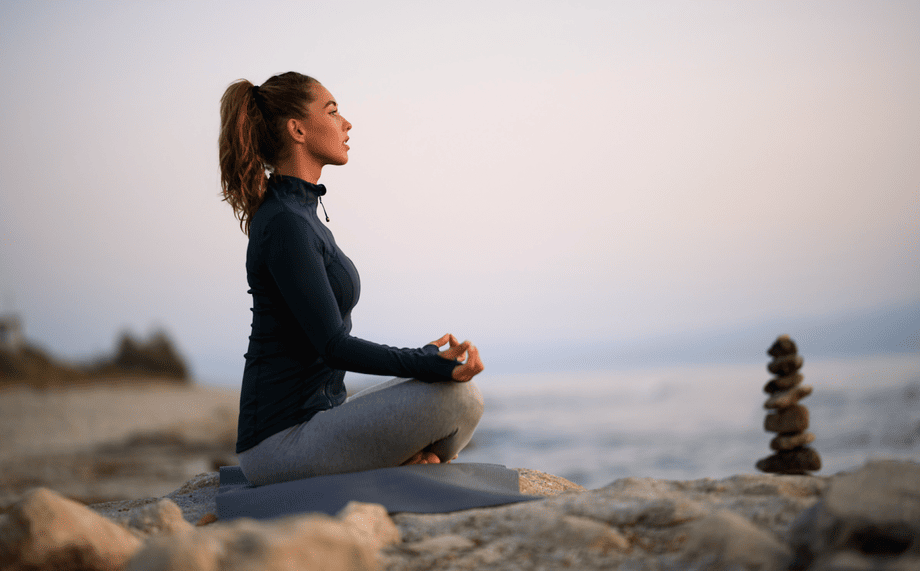Step-by-Step Guide to Breathing Meditation for Beginners

Are you a beginner looking to start a breathing meditation practice? Look no further! This step-by-step guide will walk you through the basics of breathing meditation and help you set up your meditation space.
You’ll learn how to relax your body and mind, focus on your breath, and deal with distractions. With practice, you’ll gradually deepen your meditation practice and experience the incredible benefits it has to offer.
Let’s get started!
Key Takeaways
- Breathing meditation involves focusing on the breath to deepen concentration and cultivate mindfulness.
- Setting up a quiet and peaceful meditation space is important for creating an ideal environment.
- Necessary meditation tools include cushions for support, essential oils for calming atmosphere, and proper posture.
- Relaxation techniques such as progressive muscle relaxation, deep breathing, guided imagery, and mindfulness exercises can enhance relaxation and reduce stress.
Understanding the Basics of Breathing Meditation
Now, let’s talk about the basics of breathing meditation and how it can help you relax and find inner peace.
Breathing meditation is a simple practice that involves focusing your attention on your breath. It is a powerful way to deepen concentration and cultivate mindfulness.
To begin, find a quiet and comfortable space where you won’t be disturbed. Sit in a relaxed position, either on a cushion or a chair, with your back straight but not stiff. Close your eyes and take a few deep breaths, allowing yourself to settle into the present moment.
As you continue to breathe naturally, bring your attention to the sensation of your breath entering and leaving your body. Notice the rise and fall of your abdomen or the sensation of air passing through your nostrils.
Whenever your mind wanders, gently bring your focus back to your breath. With practice, breathing meditation can bring a sense of calm and clarity to your mind, helping you find inner peace.
Setting Up Your Meditation Space
When it comes to setting up your meditation space, there are a few key points to consider.
First, creating an ideal meditation environment is crucial for a successful practice. This includes finding a quiet and peaceful area, free from distractions and clutter.
Second, gathering the necessary meditation tools, such as a cushion or mat, can greatly enhance your experience and provide comfort during long sessions.
Lastly, creating a serene atmosphere by incorporating elements like soft lighting, calming scents, and soothing music can help you relax and enter a deeper state of meditation.
Ideal Meditation Environment
Creating an ideal meditation environment involves finding a quiet and comfortable space. It is important to have a serene atmosphere that promotes relaxation and focus.
Here are some key elements to consider when creating your meditation space:
- Silence: A quiet environment helps to calm the mind and reduce distractions, allowing for deeper concentration and introspection.
- Nature: Incorporating elements of nature, such as plants or natural light, can enhance the overall sense of tranquility and connection with the environment.
- Comfort: Choose a cushion or chair that provides proper support for your body, allowing you to sit comfortably during your meditation practice.
- Minimalism: Keep the space clutter-free and organized, creating a sense of simplicity and calmness.
- Personal Touches: Add items that hold personal significance or bring you joy, such as a meaningful object or a soothing scent, to make the space feel inviting and personalized.
Necessary Meditation Tools
In order to enhance your meditation practice, it’s essential to have the necessary tools.
Two key items that can greatly enhance your meditation experience are meditation cushions and essential oils.
Meditation cushions provide the necessary support and comfort for your body, allowing you to sit for longer periods without discomfort. They also help to maintain proper posture, which is crucial for deepening your meditation practice.
Essential oils, on the other hand, can create a calming and soothing atmosphere, aiding in relaxation and focus. Lavender, for example, is known for its calming properties, while peppermint can help invigorate and awaken the senses.
Creating a Serene Atmosphere
To create a serene atmosphere for your meditation practice, you can incorporate soft lighting and calming music. These elements play a crucial role in creating a soothing ambience that helps you cultivate tranquility.
Here are five ways to enhance your meditation space:
- Use dimmable lights to create a gentle and relaxing ambiance.
- Opt for natural light sources, such as candles or salt lamps, to add a warm and peaceful glow.
- Choose instrumental music or nature sounds that promote relaxation and calmness.
- Keep your meditation area clutter-free and organized to create a sense of spaciousness and clarity.
- Consider adding elements from nature, such as plants or a small water fountain, to bring a sense of grounding and harmony to your space.
Relaxing Your Body and Mind
Take a few deep breaths and let your body and mind relax. It’s time to unwind and release all the tension you’ve been carrying. One of the most effective ways to do this is through relaxation techniques and mindfulness exercises. By practicing these techniques, you can calm your mind, reduce stress, and improve your overall well-being.
Here are a few simple techniques to help you relax:
| Technique | Steps | Benefits |
|---|---|---|
| Progressive Muscle Relaxation | Start from your toes and work your way up, tensing and releasing each muscle group. | Reduces muscle tension and promotes relaxation. |
| Deep Breathing | Inhale deeply through your nose, hold for a few seconds, and exhale slowly through your mouth. | Helps calm the mind and increase oxygen flow. |
| Guided Imagery | Visualize a peaceful scene or a place that brings you joy, using all your senses. | Promotes relaxation and reduces anxiety. |
Focusing on Your Breath
Start by closing your eyes and taking a few deep breaths to focus on your breath. As you begin your breathing meditation, here are five focusing techniques to help you stay present and reap the benefits of mindfulness:
- Notice the sensation of the air entering and leaving your nostrils.
- Count your breaths, slowly and rhythmically, to anchor your attention.
- Label your thoughts as ‘thinking’ and gently bring your focus back to your breath.
- Observe the rise and fall of your abdomen with each inhalation and exhalation.
- Embrace any distractions or discomfort with acceptance and let them pass.
By honing your ability to focus on your breath, you cultivate a sense of calm and awareness. This practice enhances your concentration, reduces stress, and promotes overall well-being.
Take a moment to prioritize yourself and start experiencing the transformative power of mindfulness.
Dealing With Distractions
When distractions arise during your breathing practice, gently acknowledge them and bring your focus back to your breath. It’s completely normal for distractions to come up while you’re trying to maintain focus. Managing distractions is an essential part of the meditation process.
Thoughts, emotions, and external noises can all pull your attention away from your breath. Instead of getting frustrated, remind yourself that this is a natural part of the practice. When you notice a distraction, simply observe it without judgment and then gently guide your attention back to your breath.
It may take some time and practice, but with consistency, you will become better at managing distractions and maintaining focus. Remember to be patient with yourself and embrace the journey of learning to stay present with your breath.
Gradually Deepening Your Practice
As you continue to deepen your meditation practice, you’ll discover a multitude of benefits that come with progression.
Not only will you experience a greater sense of calm and inner peace, but you’ll also build resilience and focus that can be applied to other areas of your life.
Additionally, as you become more advanced in your practice, you’ll have the opportunity to explore new techniques and expand your understanding of meditation.
Benefits of Progression
The benefits of progression in breathing meditation include increased focus and reduced stress levels. As you continue to practice and deepen your meditation, you will experience a range of positive effects on your mind and body. Here are some key benefits to motivate you along the way:
- Improved concentration: Through regular breathing meditation, you can train your mind to stay focused on the present moment. This enhanced concentration can then be applied to other areas of your life, allowing you to be more productive and efficient.
- Reduced stress levels: Breathing meditation has been shown to activate the body’s relaxation response, which helps to counteract the effects of stress. By incorporating this practice into your daily routine, you can cultivate a sense of calm and inner peace.
- Enhanced self-awareness: As you progress in your meditation practice, you will develop a deeper understanding of your thoughts, emotions, and sensations. This increased self-awareness can lead to greater self-acceptance and improved overall well-being.
- Improved emotional regulation: Breathing meditation can help you become more aware of your emotions and learn to respond to them in a more balanced way. By cultivating a sense of inner calm, you can better navigate challenging situations and maintain emotional stability.
- Increased resilience: Regular breathing meditation can strengthen your ability to cope with stress and adversity. It can help you build mental and emotional resilience, allowing you to bounce back from setbacks and overcome obstacles with greater ease.
Building Resilience and Focus
To build resilience and focus, keep practicing breathing meditation regularly and enjoy the positive changes it brings to your life. Breathing meditation is a powerful tool that can help you develop mental strength and improve your ability to concentrate. By incorporating this practice into your daily routine, you can enhance your resilience and sharpen your focus in various aspects of life. As you cultivate a regular meditation practice, you will notice significant improvements in your ability to handle stress, bounce back from setbacks, and stay centered amidst the chaos of everyday life. Moreover, breathing meditation can also help you improve your concentration and enhance your cognitive abilities. So why not give it a try and experience the transformative effects for yourself?
| Benefits of Breathing Meditation | ||
|---|---|---|
| Builds resilience | Improves concentration | Reduces stress |
| Enhances mental clarity | Promotes emotional well-being | Boosts self-awareness |
| Increases patience | Enhances creativity | Improves decision-making |
| Promotes better sleep | Reduces anxiety | Enhances overall well-being |
Exploring New Techniques
Now that you’ve built resilience and focus through breathing meditation, it’s time to explore new techniques that can further enhance your practice. By incorporating mindfulness techniques into your meditation routine, you can unlock even more benefits for your mind and body.
Here are five techniques to try:
- Body scan meditation: Bring awareness to each part of your body, starting from your toes and moving up to your head.
- Loving-kindness meditation: Cultivate feelings of love and compassion towards yourself and others.
- Walking meditation: Practice mindfulness while walking, paying attention to each step and the sensations in your body.
- Mantra meditation: Repeat a calming word or phrase to focus your mind and deepen your meditation.
- Visualization meditation: Imagine yourself in a peaceful and serene place, engaging your senses to create a vivid mental image.
Frequently Asked Questions
Can Breathing Meditation Help With Managing Stress and Anxiety?
Breathing meditation can be helpful in managing stress and anxiety. It has been shown to improve mental health and provide various benefits for stress reduction. Give it a try!
Is It Necessary to Sit in a Cross-Legged Position During Breathing Meditation?
No, it’s not necessary to sit cross-legged during breathing meditation. You can choose alternative positions that are comfortable for you, like sitting in a chair or on a cushion. Find what works best for you.
Can Breathing Meditation Be Practiced Lying Down?
Yes, breathing meditation can be practiced lying down. It offers various benefits like relaxation and stress reduction. Techniques such as deep belly breathing and focusing on the breath can be used for effective meditation.
How Long Should Each Session of Breathing Meditation Ideally Last?
Ideally, each session of breathing meditation should last for about 10-20 minutes. However, longer sessions can offer additional benefits such as deeper relaxation and increased focus.
Are There Any Specific Breathing Techniques That Can Enhance the Benefits of Meditation?
To enhance the benefits of meditation, you can try specific breathing techniques such as Pranayama techniques. These techniques help deepen your breath, calm your mind, and bring a sense of relaxation and focus to your meditation practice.









